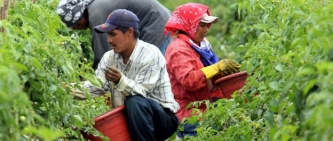
By Miguel Leyva
Photo: Farmworkers, CC-NC via Bing
August 4, 2023 (San Diego) -- Systemic racism affects nearly every facet of life for people of color. Across the country, there are serious racial disparities concerning representation, land, and money within the agricultural field. Up to 83% of farmworkers nationwide are Latino, and unlike most workers, they do not benefit from overtime protections. San Diego County is home to California's ninth most lucrative agribusiness sector, generating over $1 billion annually. Furthermore, roughly 90% of its farm revenues are derived from labor-intensive crop industries. Although they provide essential services, Latino farmworkers usually earn low wages and must endure substandard working and living conditions. Approximately 35% of San Diego County's population is Latino, and many of these people work in agriculture.
As one of the most accident-prone industries, agriculture has the highest fatality rate in the country. Farmworkers face countless safety, health, environmental, biological, and respiratory hazards every day.
They regularly use knives and hoes, work on ladders, and use machinery in their shops. When these tools are used or maintained improperly, they have the potential to cause severe, even fatal, injuries. Moreover, farmworkers risk suffocation or engulfment when working with grain bins and silos. Still, a more insidious threat to farmworkers' health is pesticide exposure, which occurs frequently within the agricultural field. Paraquat, a highly toxic herbicide, is routinely applied to crops in San Diego County, even though many countries have banned it due to its potential to cause Parkinson's disease.
Paraquat Exposure, Significantly Increasing the Risk of Parkinson's Disease in Latino Farmworkers
Every year, over 8 million pounds of paraquat are used across the country on crops such as corn, soy, cotton, wheat, almonds, sweet potatoes, and strawberries. In San Diego County, nearly 52 pounds of the herbicide are applied per acre annually. Paraquat is sold in the U.S. under dozens of names, including Gramoxone, Firestorm, Parazone, Helmquat, and Quick-Quat. In 2018, paraquat was the only top five herbicide to increase in acres treated, with 104,207 acres treated, an 8% increase compared to the previous years. Paraquat exposure is associated with a 150% higher risk of developing Parkinson's disease, and Latino farmworkers are the most vulnerable demographic.
Furthermore, paraquat exposure occurring within 1,600 feet of a home increases the risk of Parkinson's disease by 75%, so the families of Latino farmworkers and the people living near farming communities are in danger, too. Paraquat is neurotoxic, which means exposure takes a heavy toll on the brain, as once a person inhales the herbicide, the vapors can irreversibly damage the substantia nigra, a region of the brain responsible for movement control. When this part of the brain is impacted by paraquat exposure, the person starts exhibiting Parkinson's disease symptoms, such as difficulty with balance and coordination, shaking, muscle stiffness, and tremors.
Combating Systemic Racism Among Latino Farmworkers
Farmworkers are essential workers, as our food supply depends solely on their continuous labor. Despite numerous studies documenting the disproportionate level of illness among Latino farmworkers, the EPA discounted occupational exposure to toxic pesticides occurring in these vulnerable people. In fact, systemic racism is embodied in EPA's risk assessments, as they overlook people of color. The risk assessments do not include exposure to multiple chemicals, which is very common among farmworkers. Moreover, several years ago, the agency admitted that farmworkers would still be exposed to pesticide levels over the agency's safe exposure limits even with maximum feasible protective equipment and engineering controls.
The EPA establishes worker protection standards for farmworkers under the Federal Insecticide, Fungicide, and Rodenticide Act. Nevertheless, the original standards were set after field hearings in the 1970s in which growers, not farmworkers, had something to say. A solution to achieve justice for Latino farmworkers would entail Congress improving the law concerning farmworker protection regarding paraquat exposure and exposure to other toxic pesticides. It should restore partial jurisdiction over regulating pesticide-related occupational hazards to the OSHA to improve the coordination between this agency and the EPA. Farmwork is highly demanding and dangerous physical labor, so radical measures to abolish systemic racism from agriculture must be taken.
Miguel Leyva is a case manager at Atraxia Law in Rancho Bernardo. He provides support to farmworkers injured by paraquat exposure. Miguel helps people with Parkinson's disease gather and organize relevant information about their injuries so that they can subsequently file a claim.
The opinions in this editorial reflect the views of the author,and do not necessarily reflect the views of East County Magazine. To submit an editorial for consideration, contact editor@eastcountymagazine.org.











Recent comments